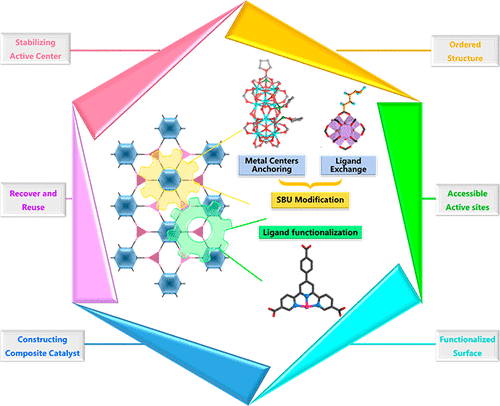当前位置:
X-MOL 学术
›
ACS Cent. Sci.
›
论文详情
Our official English website, www.x-mol.net, welcomes your
feedback! (Note: you will need to create a separate account there.)
Metal–Organic Layers for Electrocatalysis and Photocatalysis
ACS Central Science ( IF 12.7 ) Pub Date : 2020-10-30 , DOI: 10.1021/acscentsci.0c01150 Lingyun Cao 1, 2 , Cheng Wang 1, 2
ACS Central Science ( IF 12.7 ) Pub Date : 2020-10-30 , DOI: 10.1021/acscentsci.0c01150 Lingyun Cao 1, 2 , Cheng Wang 1, 2
Affiliation

|
Metal–organic layers (MOLs) are two-dimensional analogues of metal–organic frameworks (MOFs) with a high aspect ratio and thickness down to a monolayer. Active sites on MOLs are more accessible than those on MOFs thanks to the two-dimensional feature of MOLs, which allows easier chemical modification around the catalytic center. MOLs can also be assembled with other functional materials through surface anchoring sites that can facilitate charge/energy transport through the hybrid material. MOLs are thus quite suitable for interfacial catalysis like electrocatalysis and photocatalysis. In this outlook, we focus on representative progress of constructing unique interfacial sites on MOLs with designer paths for charge separation and energy transfer, as well as cooperative cavities for superior substrate adsorption and activation. We also discuss challenges and potentials in the future development of MOL catalysts and catalysts beyond MOLs.
中文翻译:

用于电催化和光催化的金属有机层
金属有机层(MOL)是金属有机框架(MOF)的二维类似物,具有高纵横比和低至单层的厚度。由于 MOL 的二维特性,MOL 上的活性位点比 MOF 上的活性位点更容易接近,这使得催化中心周围的化学修饰更容易。 MOL 还可以通过表面锚定位点与其他功能材料组装,从而促进电荷/能量通过混合材料的传输。因此,MOL 非常适合电催化和光催化等界面催化。在这一展望中,我们重点关注在 MOL 上构建独特界面位点的代表性进展,以及用于电荷分离和能量转移的设计路径,以及用于卓越基板吸附和激活的协作腔。我们还讨论了 MOL 催化剂和 MOL 以外的催化剂未来发展的挑战和潜力。
更新日期:2020-12-23
中文翻译:

用于电催化和光催化的金属有机层
金属有机层(MOL)是金属有机框架(MOF)的二维类似物,具有高纵横比和低至单层的厚度。由于 MOL 的二维特性,MOL 上的活性位点比 MOF 上的活性位点更容易接近,这使得催化中心周围的化学修饰更容易。 MOL 还可以通过表面锚定位点与其他功能材料组装,从而促进电荷/能量通过混合材料的传输。因此,MOL 非常适合电催化和光催化等界面催化。在这一展望中,我们重点关注在 MOL 上构建独特界面位点的代表性进展,以及用于电荷分离和能量转移的设计路径,以及用于卓越基板吸附和激活的协作腔。我们还讨论了 MOL 催化剂和 MOL 以外的催化剂未来发展的挑战和潜力。











































 京公网安备 11010802027423号
京公网安备 11010802027423号